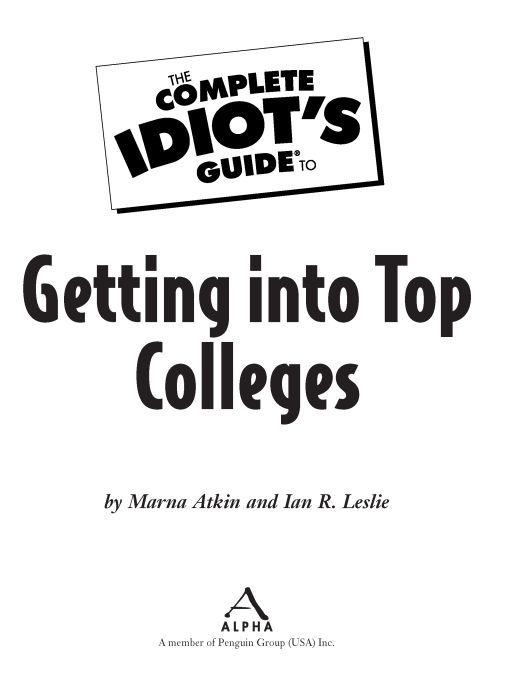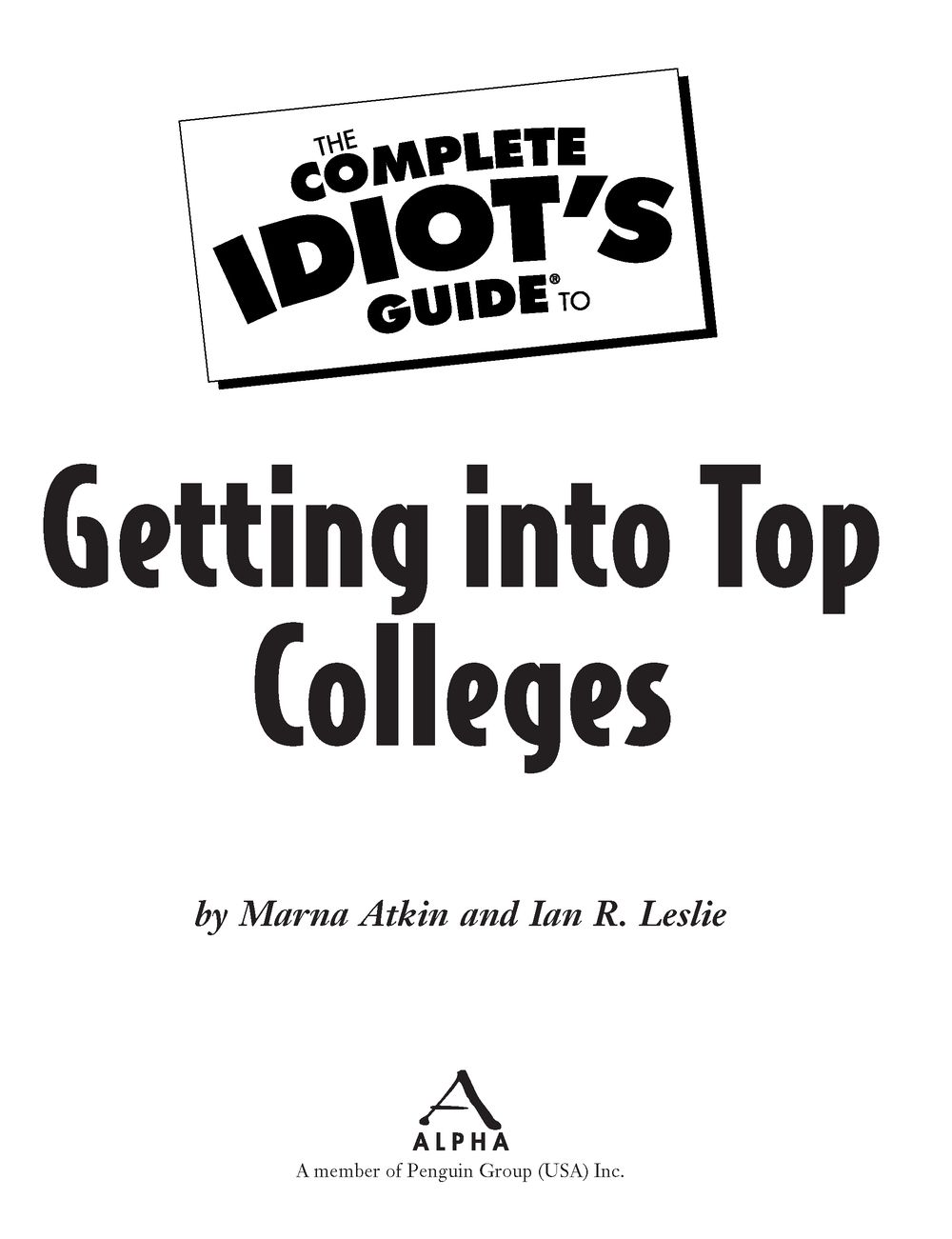Table of Contents
Marna Atkin is honored to dedicate this book to the thousands of students she has worked with over the
past 30 years and who served as her inspiration.
Ian Leslie would like to dedicate this book to his parents, Howard and Lisa Leslie, who took him on a tour
of Princeton when he was in elementary school but let him find his own way.
Introduction
Applying to college today isnt the same as it was even 10 years ago. The number of high school graduates has increased exponentially, and theyre applying to more and more colleges.
Consider these statistics:
The annual number of high school graduates will peak at about 3 milliongive or take a few hundred thousandover the next few years.
Depending on the estimate, there were anywhere from 300,000 to 500,000 more high school graduates in 2008 than there were in 1984.
In 2006, more than 2 percent of college freshmen said they had applied to 11 or more schools.
So what does this mean for you? It means its going to be even tougher to get into your first-choice school, especially if your first choice is one of the countrys top four-year colleges or universities. Youll have to work even harder to set yourself apart from the pack.
I wrote this book because I know how hard it can be to undertake the process of getting into any college, let alone a college whose diploma will open up more doors than you could imagine.
High school is filled with unique challenges and life-changing experiences. Hopefully this guide will bring you a step closer to achieving success in this challenge.
Whos This Book For?
I wrote this book with three types of students in mind.
The A+ student
A lot of A+ students dont take part in the extracurricular activities that make themselves stand out. To those students, I say its not only what you do in school that matters, but also what you do outside of school.
Harvard turned down 1,000 applicants in 2007 who had perfect scores on the math section of the SAT, according to The New York Times. Yale rejected a handful of applicants who had perfect scores on the SAT, and Princeton said thanks but no thanks to thousands of high school seniors who had a 4.0 GPA. Thats the kind of competition youre up against.
The Straight-A Do-It-All
We all know the straight-A student who does it allit might be you. You write for the school newspaper; play on the soccer team; are a member of the chemistry, biology, romance languages, and Latin clubs, and are an overall great person.
Well thats all well and good, but participating in everything is not as important or integral as becoming part of a few meaningful activities and exhibiting leadership, responsibility, and dependability. Nobody does everything well. Its just not possible or realistic. What you need to do is find your strengths and passions.
The Underachiever
There are also those who are saying to themselves, I dont have an A or A+ average, my grades typically are Bs, but I did score a 2250 on the SAT 1. Do I have any chance at getting into a top college?
What the 2250 on the SAT 1 shows is that you have ability and potential that, for whatever reason, has not been fully tapped. Perhaps you have some extenuating circumstances in your life that have prevented you from being as focused as you could have been. That is something youd want to explain on a college application, and Ill show you how to do that.
How to Use This Book
This book has been divided into five parts to help you along the way. Getting into a top college is a process that should begin even before you enter high school, but once in high school there are a succession of decisions to make and challenges to take on to ensure success. This book is based on the concept of signing up for every challenge, facing it head on, and being successful at every turn. You dont have to shut out the rest of the world to gain admission into a top college, but you do have to apply yourself.
Part 1, Its Never Too Early to Start Planning, gives you a first look at just how difficult it is to get into a top college. Its filled with information on admission rates and how to determine if you have what it takes. It also outlines the first step of working with a guidance counselor.
Part 2, Moving Forward, is just thata look at the basic steps you have to take to get into a top school, including which courses to take, which activities to sign up for, and an overview of College Board exams.
Part 3, Narrowing Your Choices, outlines the steps you need to follow before you start filling out the applications. It will help you decide to which colleges you should apply and address the college tours that occur before you head to the mailbox.
Part 4, The Application, might be the most important section and is filled with information about recommendations, essays, interviews, and how to fill out the application itself.
Part 5, Letters Start Rolling In, discusses what to do after youve received your responses. Some will be faced with the issue of deciding between a number of acceptances; others will have to consider life after rejection.
And Theres More
In addition to the information packed into the preceding sections, Ive included side-bars that will provide you with quick-hitting information about college planning.
Beware
There are pitfalls you need to be careful of when trying to get into a top college. This sidebar will offer you some warnings so you know what to look out for.
definition
Just like anything else, the college planning process has its own lingo. This sidebar will help define some of the jargon for you.
Real Life
This sidebar shares the firsthand experiences of people who have been through the college application process and attended a top college. Theyll tell you what they wish they had known going into the process and what they learned.
Cheat Sheet
These are tips Ive collected from guidance counselors, admissions officers, and college alums. The advice ranges from simple reminders about steps along the way that you cant forget to complete, to suggestions on how to make yourself stand out.
Acknowledgments
Marna would first like to thank her parents, Mickey and Harry LeVine, for their love, encouragement, and steadfast belief in education.
I would also like to thank all the people involved with this book who were so helpful and patient throughout the process: Kimberly Lionetti at Book Ends; executive editor Randy Ladenheim-Gil; and especially my coauthor, Ian Leslie, who so beautifully and eloquently put my expertise and knowledge into words. A special thank you to Mike Panetta, former colleague and dear friend, who recommended me for this project.


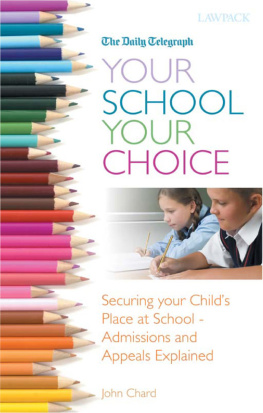
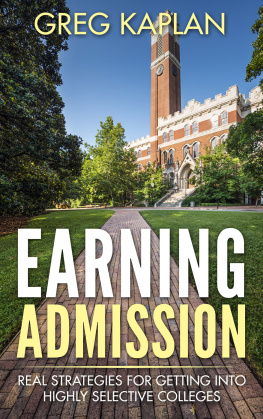
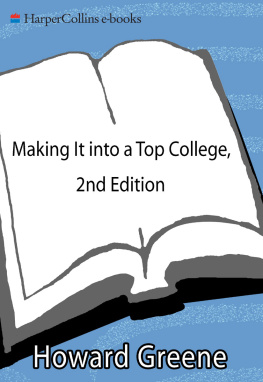

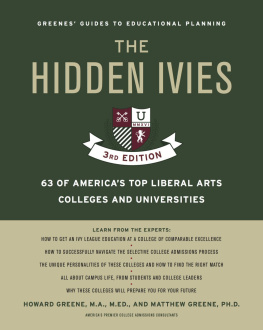
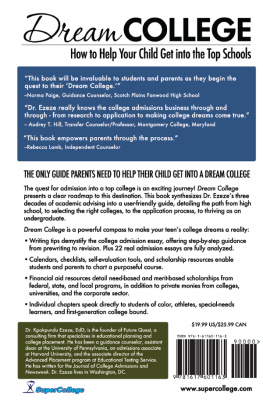
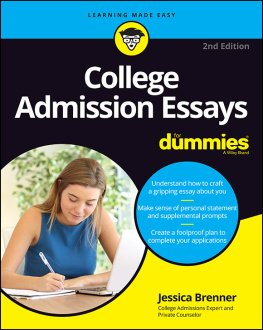
![Reding - Grads Guide to Graduate Admissions Essays] : Examples from Real Students Who Got into Top Schools](/uploads/posts/book/101661/thumbs/reding-grad-s-guide-to-graduate-admissions.jpg)
